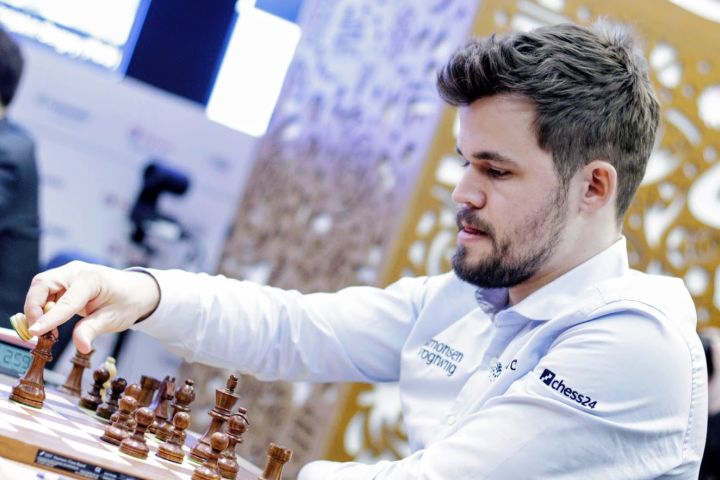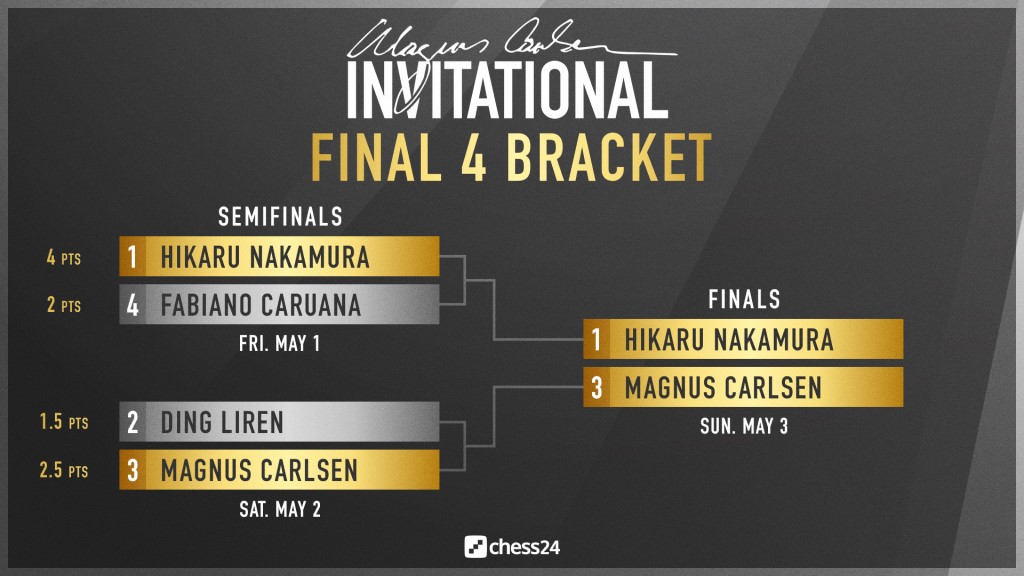


Only game one of the semi-final between Magnus Carlsen and Ding Liren went without intense drama. The 48-move draw was followed by the world champion gifting his opponent a full point by blundering after reflecting for five minutes on that very move. Ding returned the favour by blundering into mate in game three. Finally, in the fourth rapid encounter, Ding recovered from a difficult position, rejected a repetition when he had it at hand, and went on to lose the game.
An exchange between Peter Svidler and Carlsen illustrates how tense both semis felt for spectators and players alike:
Svidler: "Both semi-finals were unbelievable spectacles. [...] It was so enjoyable to watch, there was so much going on and so much drama. I don't know how enjoyable it was to play, but to watch, it was tremendous."
Carlsen: "I think it's the way it's supposed to be, that's really the point of this whole format. And no, it's not pleasant for the players at all (smiles)."
The world champion was visibly agitated by the ups and downs of the games, and was asked to compare the stress with a similar experience in over-the-board competitions. He responded:
This was dead serious. As far as tension goes, I feel sort of the same way as I felt after game ten of the match in London with Fabi.
And the tournament is not yet over, as the main event will take place on Sunday, when perhaps the most anticipated match-up — at least among those following online chess for a while — between Carlsen and Hikaru Nakamura will decide the winner of the first Magnus Carlsen Invitational.

After a 48-move draw, Carlsen got the black pieces in game two. He gained a pawn in the middlegame, but it was Ding who had the initiative. With no clear path to continue, the world champion spent nearly five minutes considering his options, until opting for a move that lost the game at once:
31...Kh7 loses immediately to 32.Rxf6 gxf6 33.Qe3, with mate-in-two on the board. Carlsen simply could not believe his eyes.
Ding was up on the scoreboard and, with black, got a better position out of the opening in game three. A dubious strategic decision let his edge slip away:
Uncharacteristically, the Chinese star did not play the most natural and cautious move while in a favourable situation — both in the game and the match — as, instead of 20...0-0 (planning to respond to 21.Ne5 with 21...Qd6), he went for 20...f6. Carlsen later got the upper hand, and won the game when Ding blundered into mate:
31...Qe7 would have kept the game going, with Black keeping some chances to muddy the waters. Ding's 31...Nf3, on the other hand, allowed 32.Bg6 and the black king is doomed. Resignation came after 32...Ng5 33.Qc8+.
The world champion wins a critical game to get back into the match against Ding Liren. https://t.co/65iJIjXWoI pic.twitter.com/eQtWVx7vQz
— Olimpiu G. Urcan (@olimpiuurcan) May 2, 2020
Tension was at its highest with one more game to go. Ding had the white pieces and got a good position out of the opening. Carlsen showed cool nerves and grabbed an exchange, giving white the more mobile pieces. It was a sharp fight, and the Chinese grandmaster decided not to force a draw by repetition on move 37:
The game would have ended peacefully, taking the match to tiebreaks, with 37.Rg3 Qh4 38.Rh3, but Ding wanted more and played 37.Nc3. Carlsen later commented that he would have done the same in that situation as "it doesn't feel like you're risking too much". Ding's valiant decision backfired though — first, he got the upper hand but failed to find the right continuation, and then he blundered with little time on the clock:
The match ended after 45.Bc2 Rd2, when Black is threatening the bishops and the g2-pawn. Carlsen was surprised when he found the rook manoeuvre that won him the match:
When I went 44...Bg7 I was just thrilled to have a safe position, which I cannot lose, and then 45.Bc2, I was like, 'Oh, 45...Rd2 just wins immediately, that's cool'.
The world champion also confessed in the post-match interview:
I haven't felt this kind of tension in a long while. This was real. [...] I haven't been in too many of these situations, to be honest, where I face just a bunch of adversities, so I guess it's good for me.
Select an entry from the list to switch between games
IM Lawrence Trent analysed the action of the day
The Magnus Carlsen Invitational is brought to you by chess24.com. Learn more about the tournament at magnuscarlsen.com/en/invitational